Financial Portfolio Management: Ms. Melody's Investment Plan
VerifiedAdded on 2023/06/09
|9
|2625
|414
Report
AI Summary
This report delves into portfolio management strategies tailored for Ms. Melody, a lottery winner with $1,900,000 to invest. It begins by outlining specific and realistic financial goals, including budgeting, debt management, and emergency funds, emphasizing the importance of diversified investments. The report calculates monthly investment amounts using the time value of money, considering a 12% interest rate over five years, and explores investment alternatives beyond the securities market, such as unit-linked insurance plans and real estate. An investment policy statement is developed, defining Ms. Melody's objectives, risk profile, and preferred securities, including Australian equities, bonds, and government bonds. The report explains various financial instruments like stocks, bonds, futures, and funds, and analyzes investment opportunities aligned with financial goals, highlighting the benefits of debt and cryptocurrencies. Recommendations are made for specific investments, emphasizing diversification across equities, bonds, and mutual funds to mitigate risk. Finally, the report evaluates the risks associated with the recommended investments, including market, equity, interest rate, currency, liquidity, concentration, credit, and reinvestment risks, while also considering the impact of diversification, taxes, inflation, and currency fluctuations on the proposed portfolio. The conclusion reiterates the importance of strategic portfolio management for achieving financial goals and maximizing returns.

ASSIGNMENT
Paraphrase This Document
Need a fresh take? Get an instant paraphrase of this document with our AI Paraphraser
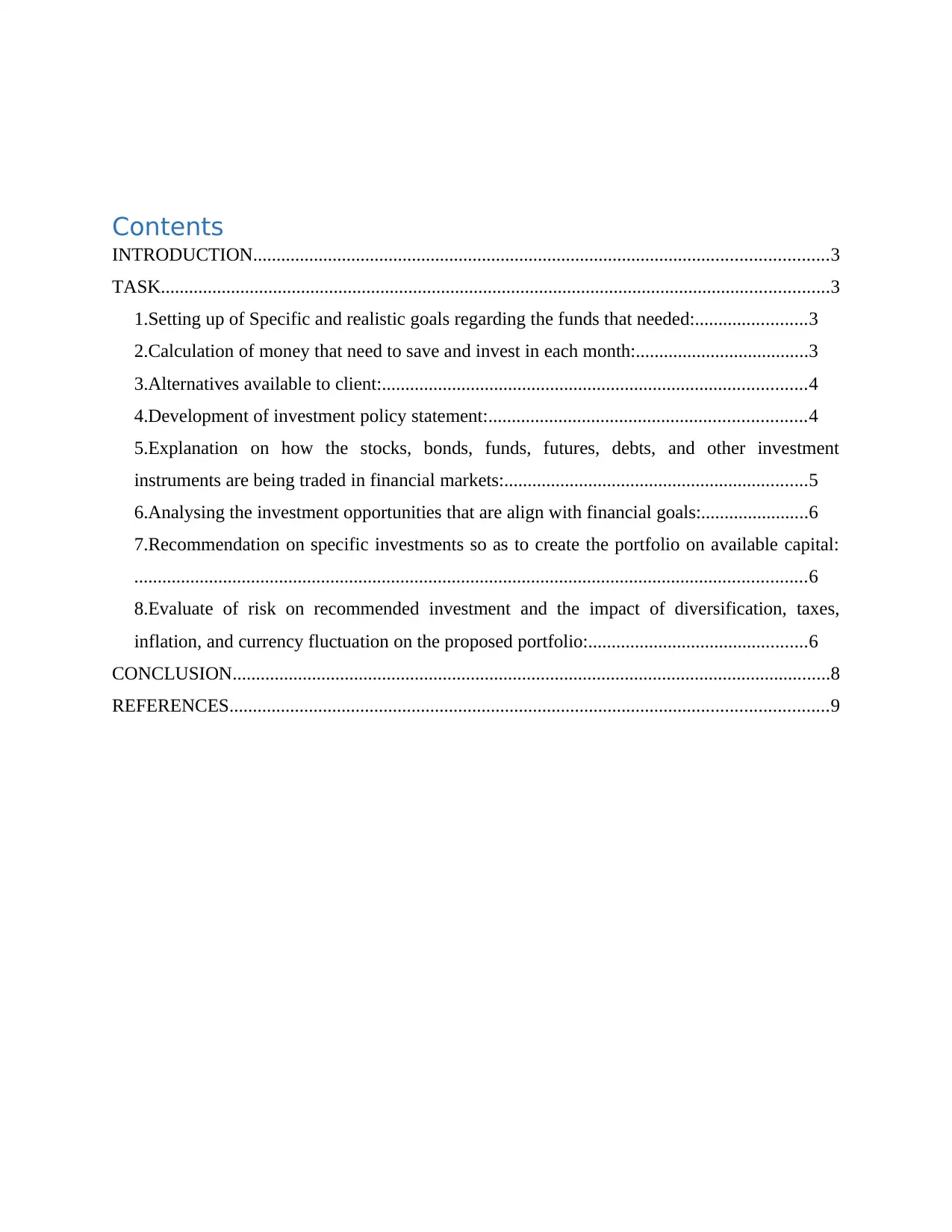
Contents
INTRODUCTION...........................................................................................................................3
TASK...............................................................................................................................................3
1.Setting up of Specific and realistic goals regarding the funds that needed:........................3
2.Calculation of money that need to save and invest in each month:.....................................3
3.Alternatives available to client:...........................................................................................4
4.Development of investment policy statement:....................................................................4
5.Explanation on how the stocks, bonds, funds, futures, debts, and other investment
instruments are being traded in financial markets:.................................................................5
6.Analysing the investment opportunities that are align with financial goals:.......................6
7.Recommendation on specific investments so as to create the portfolio on available capital:
................................................................................................................................................6
8.Evaluate of risk on recommended investment and the impact of diversification, taxes,
inflation, and currency fluctuation on the proposed portfolio:...............................................6
CONCLUSION................................................................................................................................8
REFERENCES................................................................................................................................9
INTRODUCTION...........................................................................................................................3
TASK...............................................................................................................................................3
1.Setting up of Specific and realistic goals regarding the funds that needed:........................3
2.Calculation of money that need to save and invest in each month:.....................................3
3.Alternatives available to client:...........................................................................................4
4.Development of investment policy statement:....................................................................4
5.Explanation on how the stocks, bonds, funds, futures, debts, and other investment
instruments are being traded in financial markets:.................................................................5
6.Analysing the investment opportunities that are align with financial goals:.......................6
7.Recommendation on specific investments so as to create the portfolio on available capital:
................................................................................................................................................6
8.Evaluate of risk on recommended investment and the impact of diversification, taxes,
inflation, and currency fluctuation on the proposed portfolio:...............................................6
CONCLUSION................................................................................................................................8
REFERENCES................................................................................................................................9
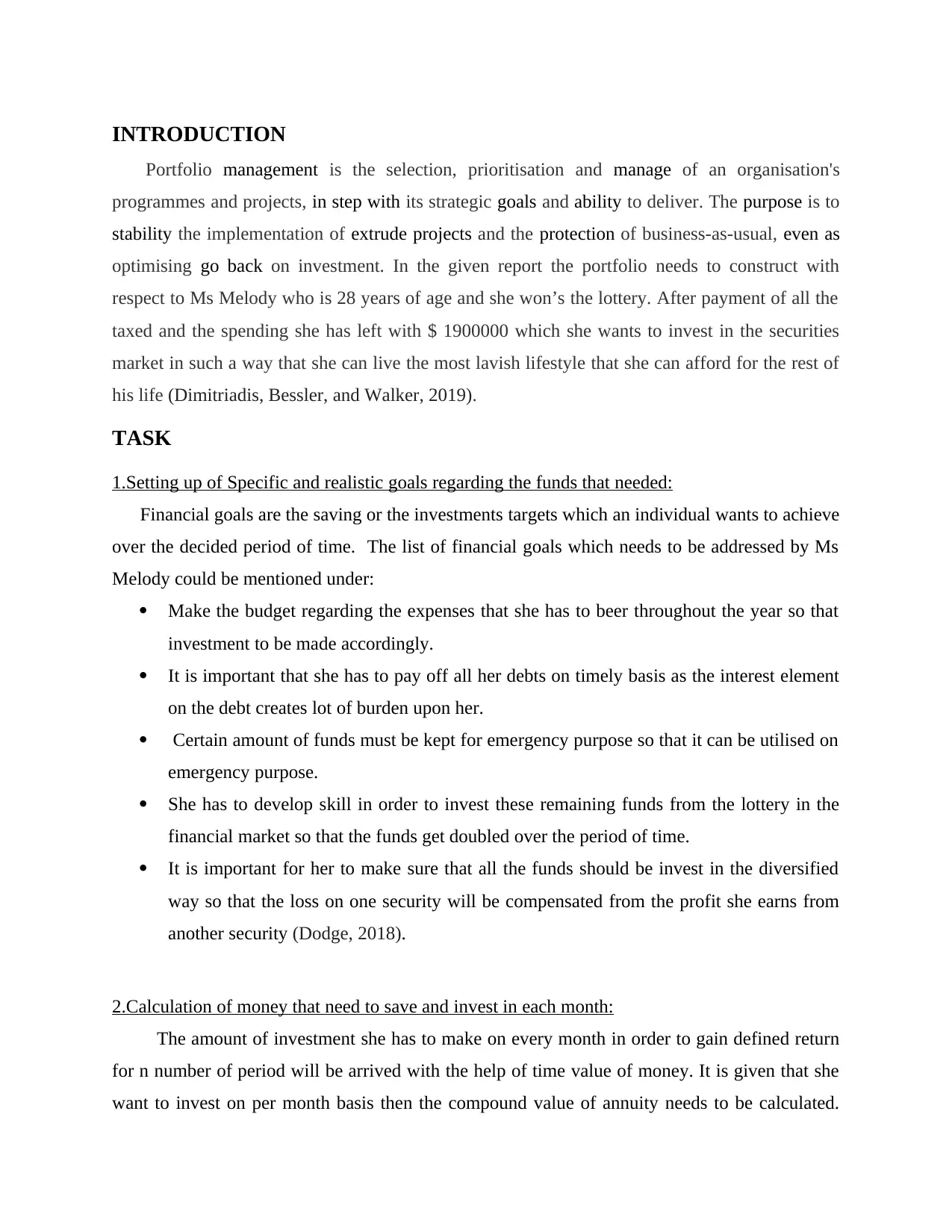
INTRODUCTION
Portfolio management is the selection, prioritisation and manage of an organisation's
programmes and projects, in step with its strategic goals and ability to deliver. The purpose is to
stability the implementation of extrude projects and the protection of business-as-usual, even as
optimising go back on investment. In the given report the portfolio needs to construct with
respect to Ms Melody who is 28 years of age and she won’s the lottery. After payment of all the
taxed and the spending she has left with $ 1900000 which she wants to invest in the securities
market in such a way that she can live the most lavish lifestyle that she can afford for the rest of
his life (Dimitriadis, Bessler, and Walker, 2019).
TASK
1.Setting up of Specific and realistic goals regarding the funds that needed:
Financial goals are the saving or the investments targets which an individual wants to achieve
over the decided period of time. The list of financial goals which needs to be addressed by Ms
Melody could be mentioned under:
Make the budget regarding the expenses that she has to beer throughout the year so that
investment to be made accordingly.
It is important that she has to pay off all her debts on timely basis as the interest element
on the debt creates lot of burden upon her.
Certain amount of funds must be kept for emergency purpose so that it can be utilised on
emergency purpose.
She has to develop skill in order to invest these remaining funds from the lottery in the
financial market so that the funds get doubled over the period of time.
It is important for her to make sure that all the funds should be invest in the diversified
way so that the loss on one security will be compensated from the profit she earns from
another security (Dodge, 2018).
2.Calculation of money that need to save and invest in each month:
The amount of investment she has to make on every month in order to gain defined return
for n number of period will be arrived with the help of time value of money. It is given that she
want to invest on per month basis then the compound value of annuity needs to be calculated.
Portfolio management is the selection, prioritisation and manage of an organisation's
programmes and projects, in step with its strategic goals and ability to deliver. The purpose is to
stability the implementation of extrude projects and the protection of business-as-usual, even as
optimising go back on investment. In the given report the portfolio needs to construct with
respect to Ms Melody who is 28 years of age and she won’s the lottery. After payment of all the
taxed and the spending she has left with $ 1900000 which she wants to invest in the securities
market in such a way that she can live the most lavish lifestyle that she can afford for the rest of
his life (Dimitriadis, Bessler, and Walker, 2019).
TASK
1.Setting up of Specific and realistic goals regarding the funds that needed:
Financial goals are the saving or the investments targets which an individual wants to achieve
over the decided period of time. The list of financial goals which needs to be addressed by Ms
Melody could be mentioned under:
Make the budget regarding the expenses that she has to beer throughout the year so that
investment to be made accordingly.
It is important that she has to pay off all her debts on timely basis as the interest element
on the debt creates lot of burden upon her.
Certain amount of funds must be kept for emergency purpose so that it can be utilised on
emergency purpose.
She has to develop skill in order to invest these remaining funds from the lottery in the
financial market so that the funds get doubled over the period of time.
It is important for her to make sure that all the funds should be invest in the diversified
way so that the loss on one security will be compensated from the profit she earns from
another security (Dodge, 2018).
2.Calculation of money that need to save and invest in each month:
The amount of investment she has to make on every month in order to gain defined return
for n number of period will be arrived with the help of time value of money. It is given that she
want to invest on per month basis then the compound value of annuity needs to be calculated.
⊘ This is a preview!⊘
Do you want full access?
Subscribe today to unlock all pages.

Trusted by 1+ million students worldwide
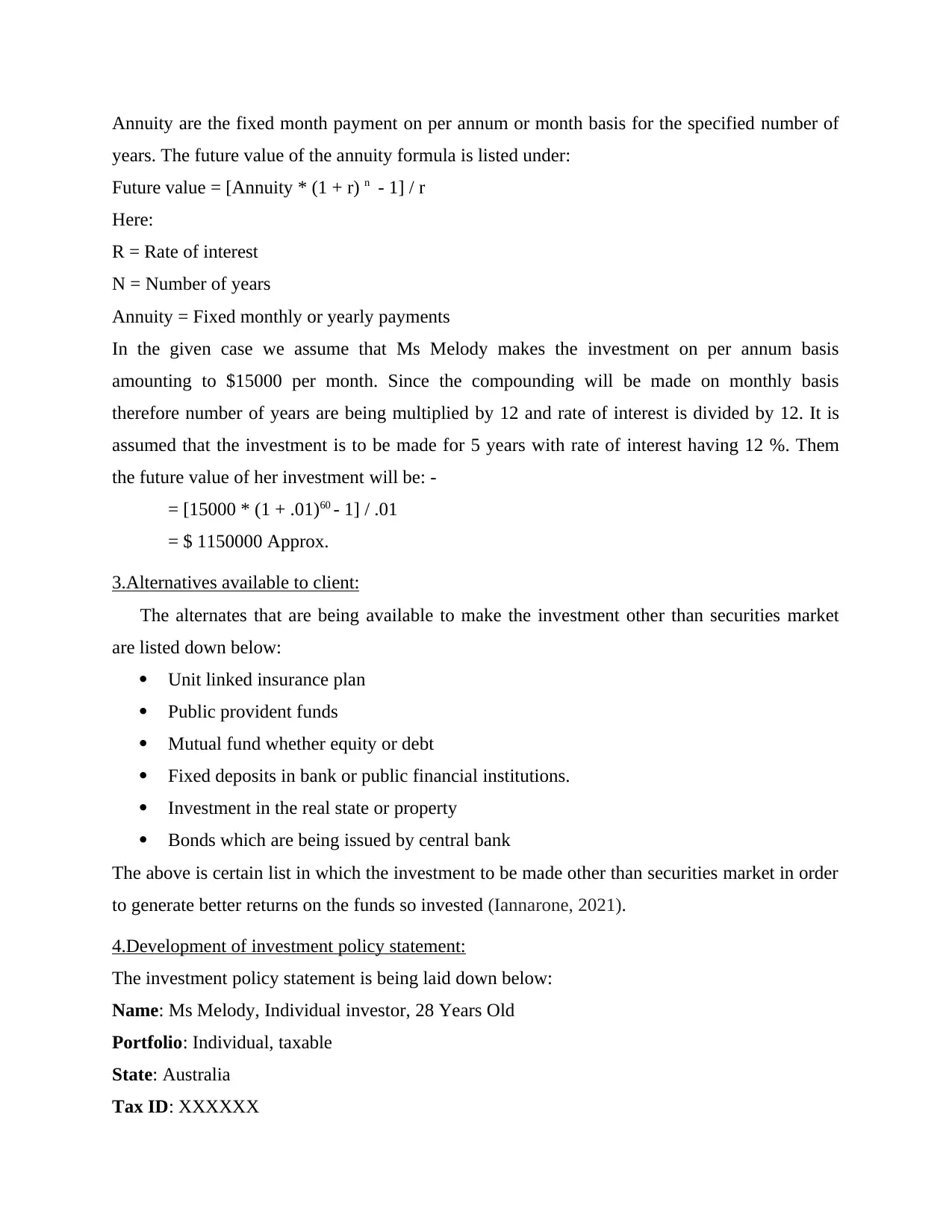
Annuity are the fixed month payment on per annum or month basis for the specified number of
years. The future value of the annuity formula is listed under:
Future value = [Annuity * (1 + r) n - 1] / r
Here:
R = Rate of interest
N = Number of years
Annuity = Fixed monthly or yearly payments
In the given case we assume that Ms Melody makes the investment on per annum basis
amounting to $15000 per month. Since the compounding will be made on monthly basis
therefore number of years are being multiplied by 12 and rate of interest is divided by 12. It is
assumed that the investment is to be made for 5 years with rate of interest having 12 %. Them
the future value of her investment will be: -
= [15000 * (1 + .01)60 - 1] / .01
= $ 1150000 Approx.
3.Alternatives available to client:
The alternates that are being available to make the investment other than securities market
are listed down below:
Unit linked insurance plan
Public provident funds
Mutual fund whether equity or debt
Fixed deposits in bank or public financial institutions.
Investment in the real state or property
Bonds which are being issued by central bank
The above is certain list in which the investment to be made other than securities market in order
to generate better returns on the funds so invested (Iannarone, 2021).
4.Development of investment policy statement:
The investment policy statement is being laid down below:
Name: Ms Melody, Individual investor, 28 Years Old
Portfolio: Individual, taxable
State: Australia
Tax ID: XXXXXX
years. The future value of the annuity formula is listed under:
Future value = [Annuity * (1 + r) n - 1] / r
Here:
R = Rate of interest
N = Number of years
Annuity = Fixed monthly or yearly payments
In the given case we assume that Ms Melody makes the investment on per annum basis
amounting to $15000 per month. Since the compounding will be made on monthly basis
therefore number of years are being multiplied by 12 and rate of interest is divided by 12. It is
assumed that the investment is to be made for 5 years with rate of interest having 12 %. Them
the future value of her investment will be: -
= [15000 * (1 + .01)60 - 1] / .01
= $ 1150000 Approx.
3.Alternatives available to client:
The alternates that are being available to make the investment other than securities market
are listed down below:
Unit linked insurance plan
Public provident funds
Mutual fund whether equity or debt
Fixed deposits in bank or public financial institutions.
Investment in the real state or property
Bonds which are being issued by central bank
The above is certain list in which the investment to be made other than securities market in order
to generate better returns on the funds so invested (Iannarone, 2021).
4.Development of investment policy statement:
The investment policy statement is being laid down below:
Name: Ms Melody, Individual investor, 28 Years Old
Portfolio: Individual, taxable
State: Australia
Tax ID: XXXXXX
Paraphrase This Document
Need a fresh take? Get an instant paraphrase of this document with our AI Paraphraser

Current Assets: $1900000 (Cash)
Return Goal: 8%
One Year Loss Limit: 15-18 % (Worst Case Scenario)
Objectives:
Long term growth and preservation of the capital
Risk profile is conservative
Time horizon is greater than 10 years
Short term Liquidity Needs are None
Securities:
Equity of Australia giving high dividend and of Small Cap.
Fixed that is bonds, government bonds, high yield bonds.
5.Explanation on how the stocks, bonds, funds, futures, debts, and other investment instruments
are being traded in financial markets:
Bond: It can be defined as an instrument that is fixed in nature it signifies the loan taken
by the borrower to the investor. The prices of bonds are inversely related to the rate of
interest such as when rates increase, the prices of the bonds fall and vice versa. In the
financial market, there are different types of bonds such as inflation-linked bonds,
perpetual bonds, bonds with 0% yield, corporate bonds, floating-rate bonds, bearer bonds,
convertible bonds, government bonds, and green bonds (Kim, Kim, and Shin, 2022).
Futures: In the financial market, it is an instrument of derivatives which is a contract for
obliging parties to purchase and sell the assets at specific future dates and prices. It helps
in hedging the movement of the price of the underlying asset which protects from
unexpected losses.
Stocks: It is also known as equity which reflects the proportion of the ownership in the
enterprise. The stock buying and selling are done on the stock exchange. There are two
categories of stocks: common and preferred.
Funds: The funds are derived from many investors which help to improve the return on
the amount invested. There are different categories of investment funds such as open-end
and close-end, index funds, hedge funds, and exchange-traded funds.
Return Goal: 8%
One Year Loss Limit: 15-18 % (Worst Case Scenario)
Objectives:
Long term growth and preservation of the capital
Risk profile is conservative
Time horizon is greater than 10 years
Short term Liquidity Needs are None
Securities:
Equity of Australia giving high dividend and of Small Cap.
Fixed that is bonds, government bonds, high yield bonds.
5.Explanation on how the stocks, bonds, funds, futures, debts, and other investment instruments
are being traded in financial markets:
Bond: It can be defined as an instrument that is fixed in nature it signifies the loan taken
by the borrower to the investor. The prices of bonds are inversely related to the rate of
interest such as when rates increase, the prices of the bonds fall and vice versa. In the
financial market, there are different types of bonds such as inflation-linked bonds,
perpetual bonds, bonds with 0% yield, corporate bonds, floating-rate bonds, bearer bonds,
convertible bonds, government bonds, and green bonds (Kim, Kim, and Shin, 2022).
Futures: In the financial market, it is an instrument of derivatives which is a contract for
obliging parties to purchase and sell the assets at specific future dates and prices. It helps
in hedging the movement of the price of the underlying asset which protects from
unexpected losses.
Stocks: It is also known as equity which reflects the proportion of the ownership in the
enterprise. The stock buying and selling are done on the stock exchange. There are two
categories of stocks: common and preferred.
Funds: The funds are derived from many investors which help to improve the return on
the amount invested. There are different categories of investment funds such as open-end
and close-end, index funds, hedge funds, and exchange-traded funds.
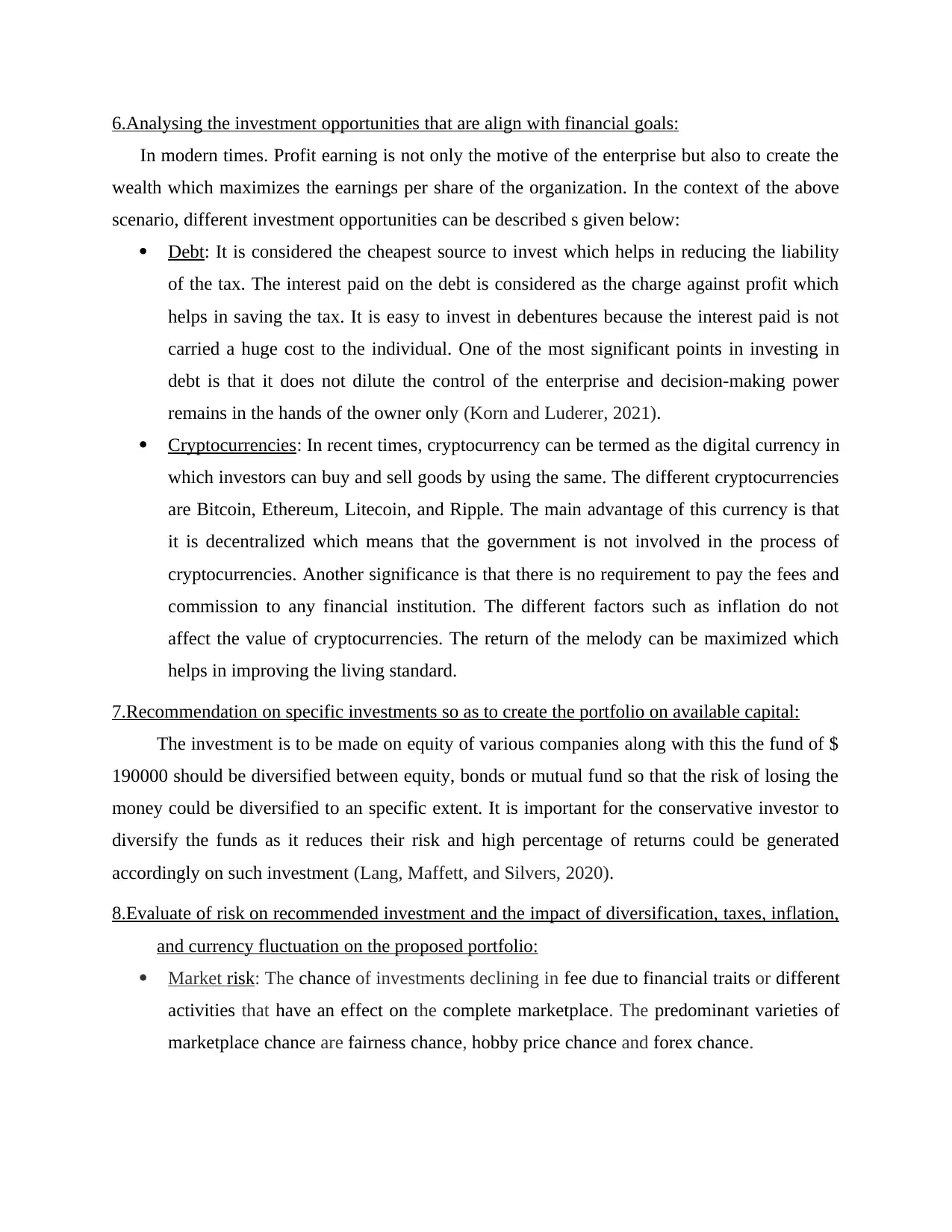
6.Analysing the investment opportunities that are align with financial goals:
In modern times. Profit earning is not only the motive of the enterprise but also to create the
wealth which maximizes the earnings per share of the organization. In the context of the above
scenario, different investment opportunities can be described s given below:
Debt: It is considered the cheapest source to invest which helps in reducing the liability
of the tax. The interest paid on the debt is considered as the charge against profit which
helps in saving the tax. It is easy to invest in debentures because the interest paid is not
carried a huge cost to the individual. One of the most significant points in investing in
debt is that it does not dilute the control of the enterprise and decision-making power
remains in the hands of the owner only (Korn and Luderer, 2021).
Cryptocurrencies: In recent times, cryptocurrency can be termed as the digital currency in
which investors can buy and sell goods by using the same. The different cryptocurrencies
are Bitcoin, Ethereum, Litecoin, and Ripple. The main advantage of this currency is that
it is decentralized which means that the government is not involved in the process of
cryptocurrencies. Another significance is that there is no requirement to pay the fees and
commission to any financial institution. The different factors such as inflation do not
affect the value of cryptocurrencies. The return of the melody can be maximized which
helps in improving the living standard.
7.Recommendation on specific investments so as to create the portfolio on available capital:
The investment is to be made on equity of various companies along with this the fund of $
190000 should be diversified between equity, bonds or mutual fund so that the risk of losing the
money could be diversified to an specific extent. It is important for the conservative investor to
diversify the funds as it reduces their risk and high percentage of returns could be generated
accordingly on such investment (Lang, Maffett, and Silvers, 2020).
8.Evaluate of risk on recommended investment and the impact of diversification, taxes, inflation,
and currency fluctuation on the proposed portfolio:
Market risk: The chance of investments declining in fee due to financial traits or different
activities that have an effect on the complete marketplace. The predominant varieties of
marketplace chance are fairness chance, hobby price chance and forex chance.
In modern times. Profit earning is not only the motive of the enterprise but also to create the
wealth which maximizes the earnings per share of the organization. In the context of the above
scenario, different investment opportunities can be described s given below:
Debt: It is considered the cheapest source to invest which helps in reducing the liability
of the tax. The interest paid on the debt is considered as the charge against profit which
helps in saving the tax. It is easy to invest in debentures because the interest paid is not
carried a huge cost to the individual. One of the most significant points in investing in
debt is that it does not dilute the control of the enterprise and decision-making power
remains in the hands of the owner only (Korn and Luderer, 2021).
Cryptocurrencies: In recent times, cryptocurrency can be termed as the digital currency in
which investors can buy and sell goods by using the same. The different cryptocurrencies
are Bitcoin, Ethereum, Litecoin, and Ripple. The main advantage of this currency is that
it is decentralized which means that the government is not involved in the process of
cryptocurrencies. Another significance is that there is no requirement to pay the fees and
commission to any financial institution. The different factors such as inflation do not
affect the value of cryptocurrencies. The return of the melody can be maximized which
helps in improving the living standard.
7.Recommendation on specific investments so as to create the portfolio on available capital:
The investment is to be made on equity of various companies along with this the fund of $
190000 should be diversified between equity, bonds or mutual fund so that the risk of losing the
money could be diversified to an specific extent. It is important for the conservative investor to
diversify the funds as it reduces their risk and high percentage of returns could be generated
accordingly on such investment (Lang, Maffett, and Silvers, 2020).
8.Evaluate of risk on recommended investment and the impact of diversification, taxes, inflation,
and currency fluctuation on the proposed portfolio:
Market risk: The chance of investments declining in fee due to financial traits or different
activities that have an effect on the complete marketplace. The predominant varieties of
marketplace chance are fairness chance, hobby price chance and forex chance.
⊘ This is a preview!⊘
Do you want full access?
Subscribe today to unlock all pages.

Trusted by 1+ million students worldwide
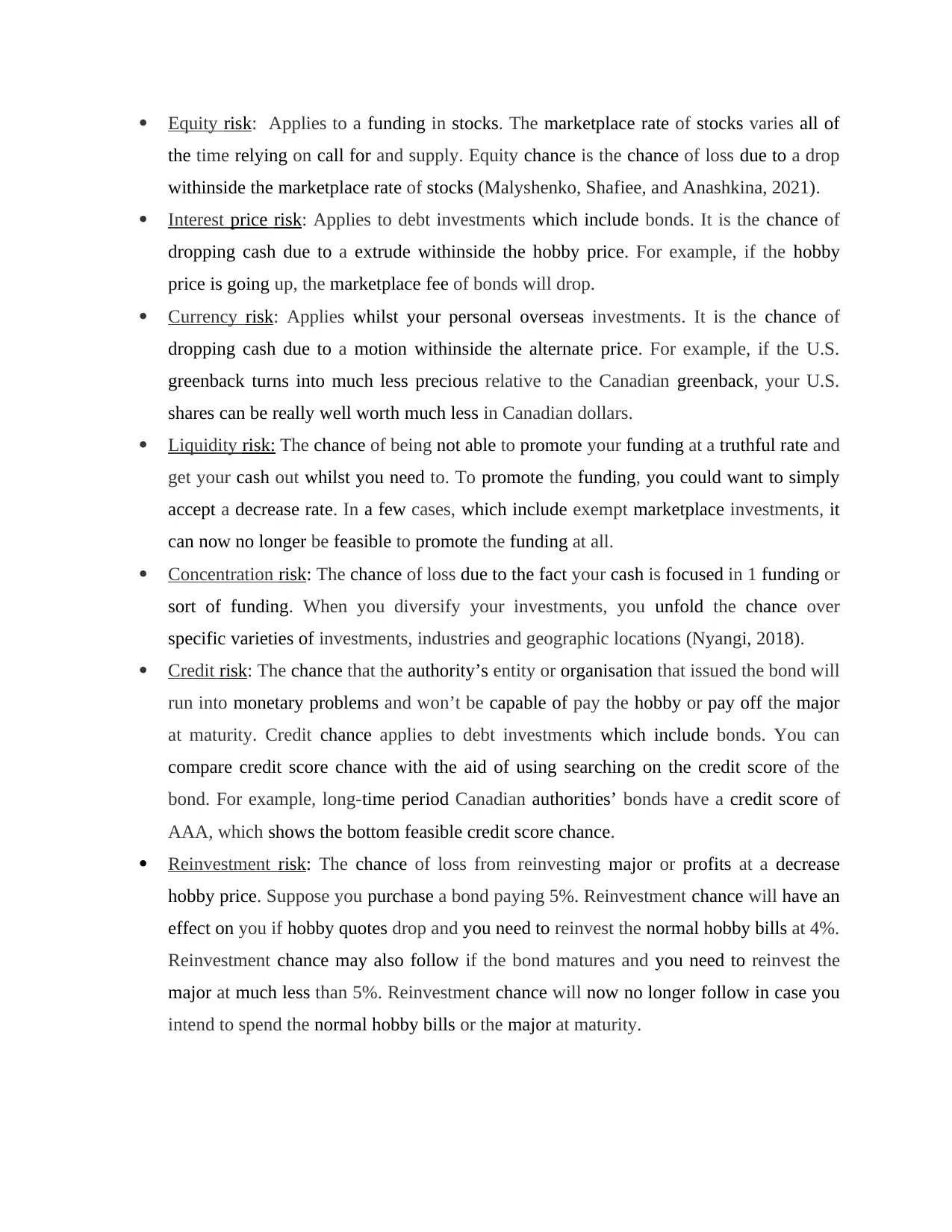
Equity risk: Applies to a funding in stocks. The marketplace rate of stocks varies all of
the time relying on call for and supply. Equity chance is the chance of loss due to a drop
withinside the marketplace rate of stocks (Malyshenko, Shafiee, and Anashkina, 2021).
Interest price risk: Applies to debt investments which include bonds. It is the chance of
dropping cash due to a extrude withinside the hobby price. For example, if the hobby
price is going up, the marketplace fee of bonds will drop.
Currency risk: Applies whilst your personal overseas investments. It is the chance of
dropping cash due to a motion withinside the alternate price. For example, if the U.S.
greenback turns into much less precious relative to the Canadian greenback, your U.S.
shares can be really well worth much less in Canadian dollars.
Liquidity risk: The chance of being not able to promote your funding at a truthful rate and
get your cash out whilst you need to. To promote the funding, you could want to simply
accept a decrease rate. In a few cases, which include exempt marketplace investments, it
can now no longer be feasible to promote the funding at all.
Concentration risk: The chance of loss due to the fact your cash is focused in 1 funding or
sort of funding. When you diversify your investments, you unfold the chance over
specific varieties of investments, industries and geographic locations (Nyangi, 2018).
Credit risk: The chance that the authority’s entity or organisation that issued the bond will
run into monetary problems and won’t be capable of pay the hobby or pay off the major
at maturity. Credit chance applies to debt investments which include bonds. You can
compare credit score chance with the aid of using searching on the credit score of the
bond. For example, long-time period Canadian authorities’ bonds have a credit score of
AAA, which shows the bottom feasible credit score chance.
Reinvestment risk: The chance of loss from reinvesting major or profits at a decrease
hobby price. Suppose you purchase a bond paying 5%. Reinvestment chance will have an
effect on you if hobby quotes drop and you need to reinvest the normal hobby bills at 4%.
Reinvestment chance may also follow if the bond matures and you need to reinvest the
major at much less than 5%. Reinvestment chance will now no longer follow in case you
intend to spend the normal hobby bills or the major at maturity.
the time relying on call for and supply. Equity chance is the chance of loss due to a drop
withinside the marketplace rate of stocks (Malyshenko, Shafiee, and Anashkina, 2021).
Interest price risk: Applies to debt investments which include bonds. It is the chance of
dropping cash due to a extrude withinside the hobby price. For example, if the hobby
price is going up, the marketplace fee of bonds will drop.
Currency risk: Applies whilst your personal overseas investments. It is the chance of
dropping cash due to a motion withinside the alternate price. For example, if the U.S.
greenback turns into much less precious relative to the Canadian greenback, your U.S.
shares can be really well worth much less in Canadian dollars.
Liquidity risk: The chance of being not able to promote your funding at a truthful rate and
get your cash out whilst you need to. To promote the funding, you could want to simply
accept a decrease rate. In a few cases, which include exempt marketplace investments, it
can now no longer be feasible to promote the funding at all.
Concentration risk: The chance of loss due to the fact your cash is focused in 1 funding or
sort of funding. When you diversify your investments, you unfold the chance over
specific varieties of investments, industries and geographic locations (Nyangi, 2018).
Credit risk: The chance that the authority’s entity or organisation that issued the bond will
run into monetary problems and won’t be capable of pay the hobby or pay off the major
at maturity. Credit chance applies to debt investments which include bonds. You can
compare credit score chance with the aid of using searching on the credit score of the
bond. For example, long-time period Canadian authorities’ bonds have a credit score of
AAA, which shows the bottom feasible credit score chance.
Reinvestment risk: The chance of loss from reinvesting major or profits at a decrease
hobby price. Suppose you purchase a bond paying 5%. Reinvestment chance will have an
effect on you if hobby quotes drop and you need to reinvest the normal hobby bills at 4%.
Reinvestment chance may also follow if the bond matures and you need to reinvest the
major at much less than 5%. Reinvestment chance will now no longer follow in case you
intend to spend the normal hobby bills or the major at maturity.
Paraphrase This Document
Need a fresh take? Get an instant paraphrase of this document with our AI Paraphraser
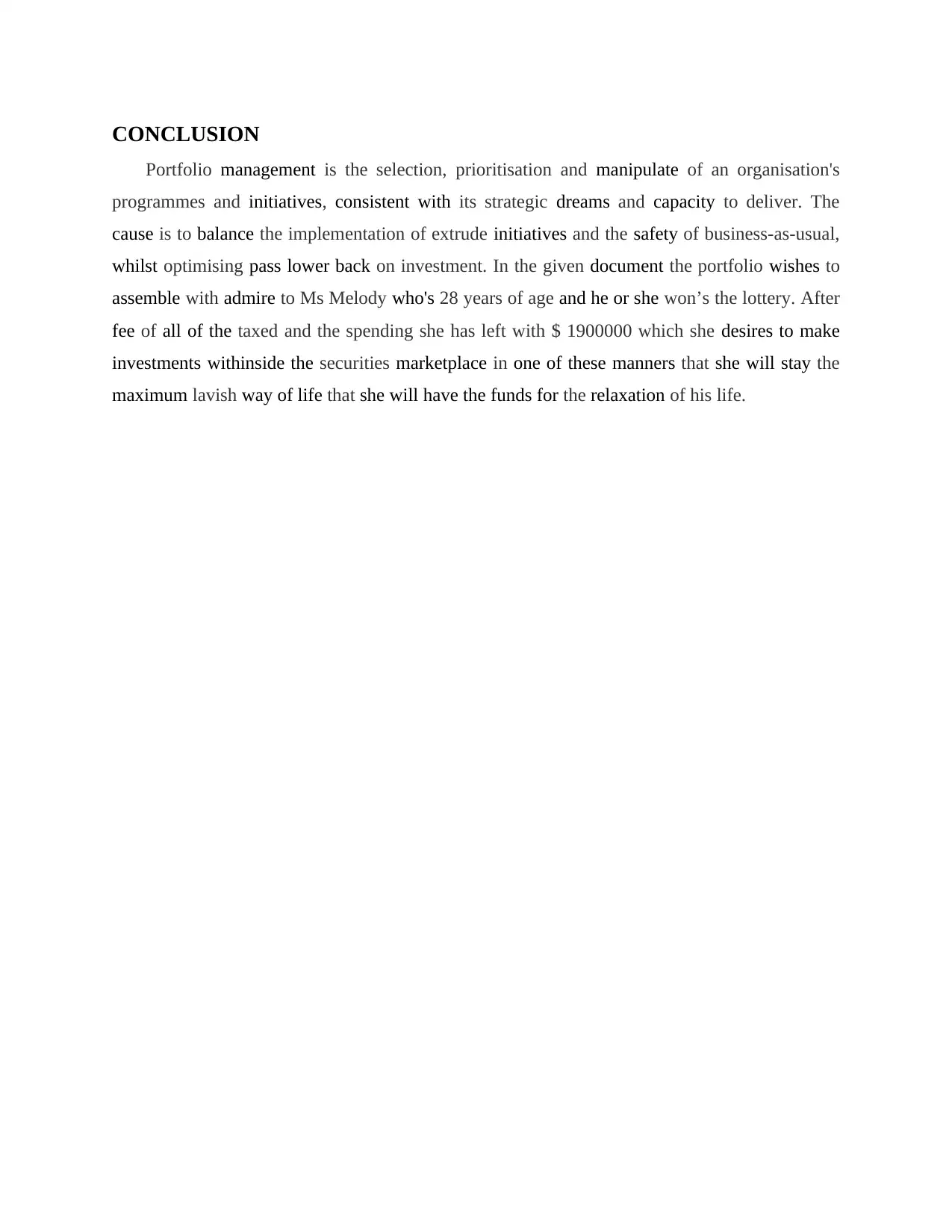
CONCLUSION
Portfolio management is the selection, prioritisation and manipulate of an organisation's
programmes and initiatives, consistent with its strategic dreams and capacity to deliver. The
cause is to balance the implementation of extrude initiatives and the safety of business-as-usual,
whilst optimising pass lower back on investment. In the given document the portfolio wishes to
assemble with admire to Ms Melody who's 28 years of age and he or she won’s the lottery. After
fee of all of the taxed and the spending she has left with $ 1900000 which she desires to make
investments withinside the securities marketplace in one of these manners that she will stay the
maximum lavish way of life that she will have the funds for the relaxation of his life.
Portfolio management is the selection, prioritisation and manipulate of an organisation's
programmes and initiatives, consistent with its strategic dreams and capacity to deliver. The
cause is to balance the implementation of extrude initiatives and the safety of business-as-usual,
whilst optimising pass lower back on investment. In the given document the portfolio wishes to
assemble with admire to Ms Melody who's 28 years of age and he or she won’s the lottery. After
fee of all of the taxed and the spending she has left with $ 1900000 which she desires to make
investments withinside the securities marketplace in one of these manners that she will stay the
maximum lavish way of life that she will have the funds for the relaxation of his life.

REFERENCES
Books and Journals
Dimitriadis, J., Bessler, and Walker, A., 2019. Securities Fraud. Am. Crim. L. Rev., 56, p.1379.
Dodge, W.S., 2018. Brief of Professors of Conflict of Laws as Amici Curiae in Support of
Appellants, in Re. Irving H. Picard, Trustee for the Liquidation of Bernard L. Madoff
Investment Securities LLC. Re. Irving H. Picard, Trustee for the Liquidation of Bernard
L. Madoff Investment Securities LLC (January 17, 2018).
Iannarone, N.G., 2021. Rethinking Automated Investment Adviser Disclosure. In The Routledge
Handbook of FinTech (pp. 347-357). Routledge.
Kim, S., Kim, S., and Shin, D., 2022. Managerial and Investor Responses to Changes in Fair
Value Accounting for Equity Securities. Available at SSRN 4030099.
Korn, R. and Luderer, B., 2021. No Risk, No Fun! Risk Indicators of Fixed-Income Securities.
In Money and Mathematics (pp. 119-124). Springer, Wiesbaden.
Lang, M., Maffett, M., and Silvers, R., 2020. Regulatory cooperation and foreign portfolio
investment. Journal of Financial Economics, 138(1), pp.138-158.
Malyshenko, K.A., Shafiee, M.M., and Anashkina, M.V., 2021. Dynamics of the securities
market in the information asymmetry context: developing a methodology for emerging
securities markets. Global Business and Economics Review, 25(2), pp.89-114.
Nyangi, G.P., 2018. Effects of behavioral biases on investment decisions of individual investors
at the Nairobi securities exchange (Doctoral dissertation, University of Nairobi).
Srivastava, A., 2021. The Impact of Pandemic on Fixed Income Securities Market in India. IUP
Journal of Bank Management, 20(3), pp.50-59.
Vijayakumaran, A., 2021. Democratizing NFTs: F-NFTs, DAOs and Securities Law. Richmond
Journal of Law and Technology.
Books and Journals
Dimitriadis, J., Bessler, and Walker, A., 2019. Securities Fraud. Am. Crim. L. Rev., 56, p.1379.
Dodge, W.S., 2018. Brief of Professors of Conflict of Laws as Amici Curiae in Support of
Appellants, in Re. Irving H. Picard, Trustee for the Liquidation of Bernard L. Madoff
Investment Securities LLC. Re. Irving H. Picard, Trustee for the Liquidation of Bernard
L. Madoff Investment Securities LLC (January 17, 2018).
Iannarone, N.G., 2021. Rethinking Automated Investment Adviser Disclosure. In The Routledge
Handbook of FinTech (pp. 347-357). Routledge.
Kim, S., Kim, S., and Shin, D., 2022. Managerial and Investor Responses to Changes in Fair
Value Accounting for Equity Securities. Available at SSRN 4030099.
Korn, R. and Luderer, B., 2021. No Risk, No Fun! Risk Indicators of Fixed-Income Securities.
In Money and Mathematics (pp. 119-124). Springer, Wiesbaden.
Lang, M., Maffett, M., and Silvers, R., 2020. Regulatory cooperation and foreign portfolio
investment. Journal of Financial Economics, 138(1), pp.138-158.
Malyshenko, K.A., Shafiee, M.M., and Anashkina, M.V., 2021. Dynamics of the securities
market in the information asymmetry context: developing a methodology for emerging
securities markets. Global Business and Economics Review, 25(2), pp.89-114.
Nyangi, G.P., 2018. Effects of behavioral biases on investment decisions of individual investors
at the Nairobi securities exchange (Doctoral dissertation, University of Nairobi).
Srivastava, A., 2021. The Impact of Pandemic on Fixed Income Securities Market in India. IUP
Journal of Bank Management, 20(3), pp.50-59.
Vijayakumaran, A., 2021. Democratizing NFTs: F-NFTs, DAOs and Securities Law. Richmond
Journal of Law and Technology.
⊘ This is a preview!⊘
Do you want full access?
Subscribe today to unlock all pages.

Trusted by 1+ million students worldwide
1 out of 9
Related Documents
Your All-in-One AI-Powered Toolkit for Academic Success.
+13062052269
info@desklib.com
Available 24*7 on WhatsApp / Email
![[object Object]](/_next/static/media/star-bottom.7253800d.svg)
Unlock your academic potential
Copyright © 2020–2025 A2Z Services. All Rights Reserved. Developed and managed by ZUCOL.





